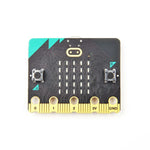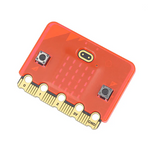Why Does STEM Learning Need to Be “Hands-On”?
In today’s world, STEM (Science, Technology, Engineering, and Mathematics) education is becoming increasingly important. It not only helps students strengthen logical thinking but also sparks creativity and cultivates problem-solving skills—core abilities essential for future study and careers.
However, traditional classrooms often rely too much on theory. Students passively receive knowledge, with little chance to explore and practice. As a result, many feel that STEM is abstract and dull, making it difficult to truly grasp its essence.
Against this backdrop, the micro:bit robot kit has become an ideal learning tool. It brings knowledge to life, turning abstract concepts into hands-on experiments that allow students to learn by doing. As a leading brand in STEM education, ELECFREAKS is dedicated to offering innovative robot kits that make learning more engaging and effective for both students and teachers.
What is a micro:bit Robot Kit? ——The Starting Point for STEM Coding and Robotics
The BBC micro:bit is a tiny programmable development board launched by the BBC, designed specifically for education. Compact yet powerful, it has been widely adopted by STEM teachers worldwide.
A robot kit builds on the micro:bit by combining motors, sensors, and structural parts to create a programmable robotics learning platform. Students can both assemble robots and program them to complete various tasks.
Take the ELECFREAKS Cutebot Kit as an example:
1. The kit includes motors, ultrasonic sensors, line-tracking modules, RGB LED lights, and other core components.
2. Once a micro:bit board is inserted, the car can move forward, turn, avoid obstacles, follow lines, and interact with lights.
3. Students can get their first “smart car” running in as little as 10 minutes.
4. This modular design dramatically lowers the entry barrier, enabling more learners to quickly step into the world of STEM.
Why Does a micro:bit Robot Kit Make STEM Learning More Fun and Effective?
1. Interactivity
Instead of dealing only with static formulas and text, students can directly see how their code makes the robot move, light up, or even “dance.” This interactivity makes learning exciting.
When students write a simple block of code in MakeCode to turn on the Cutebot’s LED lights, they immediately see the lights flash in real life. When they adjust motor commands, the car actually changes direction. These visible, physical outcomes make abstract coding concepts tangible and memorable.
2. Instant Feedback
Whether the logic is correct becomes clear through the robot’s movement or light responses. Students can quickly fix mistakes, and this immediate feedback encourages more active learning.
Instead of waiting for test scores or teacher corrections, students instantly know if their algorithm is wrong when the car bumps into an obstacle or fails to follow a line. This short feedback loop mirrors real-world engineering cycles, where trial and error are part of innovation.
3. Cross-Disciplinary Integration
With a micro:bit robot kit, students don’t just learn coding in isolation—they apply knowledge from multiple STEM fields. Programming a Cutebot to follow a path requires math for calculating distances and angles, physics for understanding how motors and sensors work, and engineering for optimizing wheel alignment. By combining these disciplines, students see how subjects connect in real-world problem-solving, making learning more holistic and meaningful.
4. Creativity and Innovation
Once students master the basics, robot kits become a platform for open-ended exploration. They can design challenges like guiding the Cutebot through a maze, staging a synchronized “dance performance,” or even adding extra sensors for new functions. This freedom unleashes creativity and empowers students to become inventors, not just learners—encouraging them to think outside the box and turn imaginative ideas into working prototypes.
Unique Advantages of the ELECFREAKS Cutebot Kit
Compared to other STEM learning tools, the Cutebot Kit stands out with:
Modular Design:
Plug-and-play, perfect for beginners. Unlike traditional electronics kits that require soldering or complex wiring, the Cutebot lets students simply insert a micro:bit and start coding. This reduces frustration and lowers the learning curve.
Diverse Sensors:
Supports line-following, obstacle avoidance, speed control, and light interactions. Students can simulate real-world technologies, such as self-driving car lane detection or smart lighting systems, giving their learning direct relevance to modern innovations.
Wide Programming Compatibility:
Works with MakeCode’s block-based coding and Python, meeting the needs of learners at different levels. Beginners can start with drag-and-drop blocks, while advanced learners transition to Python for more flexibility. This progression ensures the kit grows with the student’s skills.
Rich Educational Resources:
ELECFREAKS provides full lesson plans, tutorials, and a global community to support teachers and parents. Step-by-step guides and lesson packs align with classroom goals, while online forums allow educators to share best practices.
Application Scenarios: Fun in Classrooms and at Home
Classroom Use:
Teachers can demonstrate principles of autonomous driving with the Cutebot, while students collaborate in groups to tackle line-following and obstacle-avoidance challenges. This not only boosts STEM skills but also nurtures teamwork.
One group might focus on writing the code, another group tests the robot on a track, and a third documents the process. At the end, teams present their solutions—building both technical and communication skills.
Home Practice:
Parents and children can assemble and program the car together, guiding it through a track. This fun activity strengthens family bonds while extending STEM learning beyond the classroom.
Children can design their own obstacle courses at home, using everyday objects like books or cups, and then challenge the robot to navigate them. This playful environment encourages continuous learning even outside school hours.

Conclusion
The micro:bit Robot Kit demonstrates how STEM learning can be both fun and hands-on. By turning abstract concepts into practical experiments, it allows students to develop logical thinking, creativity, and cross-disciplinary problem-solving skills in an engaging way.
As one example, the ELECFREAKS Cutebot Kit shows how a modular, beginner-friendly robot car can support different learning scenarios in classrooms and at home. With its compatibility with MakeCode and Python, and its integration of sensors and motors, it provides a versatile entry point into robotics and programming.
Ultimately, micro:bit robot kits help bridge the gap between theory and practice in STEM education. They give learners opportunities to experiment, collaborate, and innovate—skills that extend far beyond the classroom and prepare students for future challenges.











